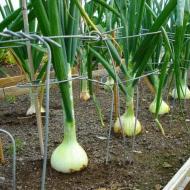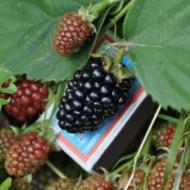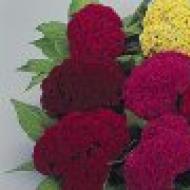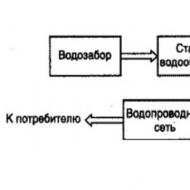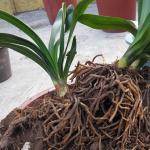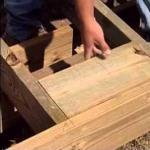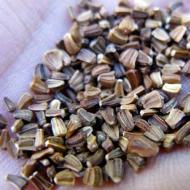
Geranium varietal terry. The best varieties and features of growing terry geraniums
Perennial plant terry pelargonium (geranium) is one of the most popular profusely flowering plants and it belongs to the Geranium family. To date, geranium is not only a decoration of gardens, flower beds, but also home window sills. In addition to the fact that terry pelargonium blooms with chic inflorescences, it differs from other plants in unpretentious care. Initially, the birthplace of the plant is Africa. There are 22 varieties of terry pelargonium.
- 1. Plant bushes are very compact.
- 2. Flowering lasts a long period (almost all year round).
- 3. The flower grows and develops rapidly.
Show all
Pebbles
According to the description, this plant belongs to the miniature. The flowers of the Pebbles variety are double, pink-raspberry in color and have a clarified center. Compared to the small size of the bush, lush inflorescences look very large.
Despite the fact that every year new plant varieties are being developed, this one always remains in sight and is popular among flower growers. Such a pelargonium easily lends itself to the formation of a bush and is undemanding to care. The variety can be grown not only on the home windowsill, but also in flower beds. Also, the volume of the inflorescence is given by the reverse side of the petal, it is almost white.
Pelargonium Pebbles

Shelk Moira
This varietal pelargonium is a representative of dwarf varieties. This variety was the first to be officially recognized by Russian breeders. This variety was brought out by a Russian woman living in St. Petersburg, Irina Kleimova. Shelk Moira is a very showy plant that has delicate double petals that have an unusual light salmon hue and bright emerald foliage.
Also densely doubled inflorescences have numerous waves at the tips of the petals, on the back side the petal is lighter. Such a plant has dense buds.
Pelargonium Shelk Moira

Brookside Fantasy
This plant is a prominent representative of the zonal type. The bushes are very compact and have rich green leaves, also on the surface of the leaves are dark, well-defined stripes. The buds of this type of pelargonium are terry and have a delicate pink-lilac hue.
When the buds have not yet reached the opening stage, the central petals are painted in a greenish tint. In the process of bud ripening, the reverse side of the petals turns into a pink-cream shade, which is not much lighter than all the inflorescences. The plant has large flower caps, the size of which is the same as that of a standard plant bush, although this variety is miniature.
Pelargonium Brookside Fantasy

Bold Carmine
This variety belongs to both semi-double and double plants. This plant is compact, favorably tolerates various top dressings and often produces long flower stalks on which fluffy red-crimson caps form.
On the back side, the petals are painted in a lighter shade of crimson red than on the outside. This flower has bright foliage, dark green stripes are clearly visible on each leaf.
Pelargonium Bold Carmine
Saxdalens Selma
This variety belongs to the zonal type. The flower is quite strong, has powerful shoots and voluminous lush inflorescences, which consist of flowers of a pale pink hue. Flowering in this variety is quite common. If the plant is properly cared for, then it will constantly delight with beautiful flowering.
Although the flower bush is strong, but it is not large, its shoots branch easily. By the appearance of the inflorescences, it is difficult to say that this plant belongs to the zonal type, since the flower resembles rosaceous varieties.
Pelargonium Saxdalens Selma
Mimi
This is a very bright and showy variety. The bushes of such a plant are small in size, but have a strong root system. It is not difficult to recognize the Mimi variety among other varieties and types of pelargonium, since the leaves of the plant are painted in a bright golden green hue, and the inflorescences are light and airy, while their color is very beautiful - salmon pink.
The advantages of this variety are many and they include the following:
Pelargonium Mimi
le pirate
It is one of the most popular terry varieties. Such a plant is able to delight with its lush inflorescence around the clock. This variety has many similarities with rosaceous plants. For example, newly blossomed buds are very reminiscent of rosebuds.
The surface of the petals is velvety and they are painted red. The leaves of the flower are ivy-shaped and bright green. Pelargonium species le Pirat is great for decorating verandas and gardens, as its flowers do not crumble for a long time.
Pelargonium le Pirat
Noel Gordon
This variety belongs to densely double plants. The appearance of the flower inflorescences is in many ways reminiscent of rosebuds, so this variety is often referred to as rosaceous varieties. The foliage of Noel Gordon is dense and has a bright green tint. In height, the flower bush can reach 30 cm. The root system is strong and well developed.
Like the previous terry variety, this one can delight with its lush pink bloom for a long time. For a long time, the petals do not crumble. The Noel Gordon variety is great for decorating garden plots, parks and apartment balconies.
Pelargonium Noel Gordon
P.A.C. Viva Maria
Pelargonium of this species has German roots. Like her German relatives, she has a lush, beautiful and long flowering, as well as compact bushes. The PAC Viva Maria variety is easy to identify among the many representatives of other varieties, as the plant has pink inflorescences, in the center of which there is a bright pink spot.
The flower is undemanding to care. It grows slowly, but the seedlings take root easily. The foliage of the flower is painted in light green color. The flowering period of PAC Viva Maria is quite long and lasts from spring to autumn.
Pelargonium PAC Viva Maria
Powder Puff
This variety is often used as a decoration for gardens, window sills, balconies and shop windows. Such decorative value is due to the presence of dense salmon-colored inflorescences and bright green leaves, on the surface of which there is a contrasting strip along the entire leaf.
The outer side of the petal has a more saturated shade than the back. The plant is small in size, so many flower growers like to grow it on indoor window sills.
Pelargonium Powder Puff
Lake
The central part of the petals of this variety is colored in a richer salmon shade than the edges of the petals. This plant loves to be in the sun, therefore, so that the shade of the inflorescences does not become pale, it is recommended to put the flower in places well lit by the sun.
Variety Lake belongs to the standard zonal type of pelargonium, therefore, it needs periodic shaping pruning. Such a flower is valued not only for its beautiful inflorescences, but also for its attractive foliage. Variegated pelargonium on each leaf has a brown-green border.
Pelargonium Lake
Ludwigsburger Flair
This is a variety that belongs to dwarf plants. However, in order for the flower to really look like a miniature plant, the grower must periodically do formative pruning.
Blooms Ludwigsburger Flair profusely and densely. Terry inflorescences are painted pink, the center of the petals is much brighter than the main shade, and the tips of the petals are white.
Pelargonium Ludwigsburger Flair
Mallorca
The variety of zonal pelargonium Mallorca belongs to cactus plants. It has interesting unusual flowers that have a pointed edge. The flowers of the plant do not have a monochromatic color and combine white, red and green.
Able to easily and often form new inflorescences. If the bush is in a poorly lit place, then its stems will stretch to the size of a standard plant. If the flower is in a sunny place, then it will grow slowly, keeping its small size.
Pelargonium Mallorca
dowepoint
This terry variety stands out among numerous plants of other varieties due to the presence on the leaves of a neat decorative border and soft pink flowers. Bushes do not grow to large sizes, they reach a height of up to 25 cm, and the bushes are also squat and branch well.
Compared to the size of the bushes themselves, the flower inflorescences are very dense and voluminous. Blooms all year round.
Pelargonium Dowepoint
Elmsett
The dwarf variety Elmsett is a zonal variety of the plant. The leaves of such a plant are bright and have a golden hue. Terry geranium flowers are cream-colored and decorated with red streaks and spots.
The flowering of the bush lasts a long time, it is very plentiful and incredibly beautiful. Pelargonium Elmsett is used to decorate houses, it looks very organic on window sills.
Pelargonium Elmsett
Lara Harmony
The flowers of the Lara Harmony variety are very reminiscent of rosebuds in appearance, so the plants are often confused. Despite the similarity with rose plants, Lara Harmony belongs to terry.
As for the size of the bush, it is standard, the leaves are bright green, classic for this species. The plant blooms with lush, elegant flowers that have a pink color.
Pelargonium Lara Harmony
norrland
This plant variety has strong long shoots and rich green foliage, which are typical for representatives of zonal varieties. Inflorescences in appearance are very similar to peony flowers.
It is thanks to the interesting inflorescences that Norrland pelargonium has gained popularity and is very much appreciated by flower growers. In order for the plant to please with abundant flowering for a long time, it needs proper care, which consists in pruning, watering and top dressing.
Geranium was discovered in vast Africa. It belongs to the Geraniev family. In Europe, the flower first appeared in the 16th century. Even despite the colder climate, he easily acclimatized to the area. It was the easy adaptation to various weather conditions that caused the geranium to become popular all over the world. On the territory of Russia, this flower began to be used to decorate rooms and flower beds in the 18th century.
In addition, this plant is found not only at home, but also in the natural environment. You can see unusual wild geranium inflorescences in the Caucasus and Europe. The popular name is crail or stork flower, but this is only in wild (weedy) species.
Description and legends

pink geranium
In the East, there is a legend that tells about the unusual origin of geraniums. It says that there were times when no one noticed her, because the flower looked like the most common weed. Once the prophet Mohammed, descending from the mountains, took off his wet cloak and threw it on the ground. She landed on an inconspicuous bush, which turned into bright sunlight and helped the cape dry quickly. In gratitude, the prophet endowed the green bushes with lush bright inflorescences, which could also be of great benefit to people.

red pelargonium
From that moment on, pelargonium began to enjoy incredible popularity.
The girls fixed the flowers on their hats, and the man used geranium leaves as decoration, which were attached to clothes.
Soon, healers learned that the plant was able to protect the population from lice and used it as the basis for various ointments. Also, the most common at first glance, the flower helped people escape after burns or when they received wounds of varying degrees.
A small unusual flower was able to cure the lameness of Emperor Peter I. This, by the way, is an approved fact in history.
What does a geranium look like
Indoor geraniums are herbaceous or semi-shrub plants, characterized by straight or falling shoots. Pelargonium attracts the attention of others not only with its terry inflorescences, but also with original leaves. You can find wide, slightly rounded, smooth, corrugated, variegated or green leaves.
Geranium or Pelargonium

hybrid geranium
There are two types of geraniums, which are indoor and garden flowers. Outwardly, they are very similar, but in fact they are different plants.
Garden geranium can be grown both in a regular garden plot and at home in a pot in any room, and pelargonium is considered a capricious plant that can only get along in a heated house.
Indoor, non-hybrid varieties, which could still be found on the windowsills of our grandmothers, were simply called “Kalachik”. They still spread a strong specific aroma around them, some liked it, well, while others could not stand it even in the spirit, allergic reactions could even begin to appear, in the form of coughing, sneezing or lacrimation. In general, there was little pleasant.
The most common varieties of room geraniums:


pink pelargonium

At home, with proper care, pelargoniums can grow and have a decorative effect for up to five years without a transplant, which often injures them. And in ideal conditions, there are specimens with a 10-year period.
Popular types and varieties of room pelargonium:

Geranium cultivation and care
Geranium easily tolerates cold, but if the air temperature drops below + 10 C, then it may stop blooming. For this unpretentious plant, the most suitable temperature is +18 +22 C in summer and from +10 to +15 C in winter.

Geraniums in pots

Geranium on the balcony
The flower loves heat very much, so places with direct sunlight are suitable for it. In the midst of summer, she will need slightly shaded areas. But this does not mean that you urgently need to rearrange the flower pot to the north window, because there, most likely, it will not produce beautiful inflorescences. The most suitable will be the south, southeast, east and northeast side. In the event that the geranium was placed in an inappropriate place for it, then it will begin to stretch.
Those bushes that stand in places with suitable lighting have rich shoots and leaves. In the summer, pots should be put outside.
Suitable places can serve as open balconies or verandas, as well as open ground, where it is recommended to plant a plant.
In the autumn, geraniums must be returned to a warm room. At this point, you need to make sure that on the street it has not been attacked by any diseases or pests, which will avoid infecting other indoor plants. Protect the flower from other plants for about a month, and if you notice that symptoms of diseases have appeared, treat it with fungicides and insecticides.
How to properly water
Geranium is a plant that loves timely and plentiful watering. At the same time, not a strong drying of the soil in a pot is not scary for her. Overwatering is dangerous for the plant, since especially in winter it can lead to rotting of the roots, which means that the geranium may soon die.
This flower differs from other indoor plants in that it does not like spraying, which leads to the loss of its decorative effect. For geraniums, it does not matter what the humidity in the room will be, which allows it to grow and bloom even in dry air.
Royal pelargonium: how to form a lush bush video:
Is top dressing necessary
 It is worth starting to feed the plant from the beginning of March and continue until August, precisely at the time of the plant's vegetation.
It is worth starting to feed the plant from the beginning of March and continue until August, precisely at the time of the plant's vegetation.
If you want the inflorescences to be lush and plentiful, then 2 times a month it is worth using potash fertilizers.
If you decide to use complex fertilizers, then opt for those that contain the least nitrogen compounds.
The fact is that this element will allow the bush to grow foliage, but the flower will release buds much more slowly.
Indoor geranium pruning for abundant flowering
 This procedure should be carried out at the end of winter or early spring, which allows you to give the geranium a shape. It is necessary to remove the old stems, which stimulates the growth of the shoots and allows the young branches to grow, gain strength and health.
This procedure should be carried out at the end of winter or early spring, which allows you to give the geranium a shape. It is necessary to remove the old stems, which stimulates the growth of the shoots and allows the young branches to grow, gain strength and health.
Do not pinch and cut geraniums in autumn or early winter.
You need to pinch the plant in order to form a compact and beautiful bush. And if you do not do this, then your pet will grow in different directions, possibly with thin untidy branches.
So the appearance of the pet is completely concentrated in your skillful and sensitive hands.
How to propagate geranium
Breeding pelargonium can be done in two ways:
- cuttings
- By dividing the bush

 To quickly propagate the plant, as a rule, cut tops of geraniums are used, so the young flower will be completely identical to the bush from which the shoot was taken. Using this method will allow you to enjoy flowering in the first summer after the plant has taken root.
To quickly propagate the plant, as a rule, cut tops of geraniums are used, so the young flower will be completely identical to the bush from which the shoot was taken. Using this method will allow you to enjoy flowering in the first summer after the plant has taken root.
In order to protect the stalk from any diseases, it is necessary to pour boiling water over the cut point, treat with potassium permanganate and sprinkle with crushed activated charcoal. Also, in order for roots to appear on the process, it can be put in water.
The division of the bush is also used to propagate geraniums. To do this, you need to remove the plant from the pot, shake off the roots from the soil and carefully divide them into several parts. Each individual root must be planted in a separate container.
How to transplant at home for beginners
There is no need to transplant geraniums, and the plant does not like this procedure.
 Basically, transplantation is carried out only if the root system is visible or already crawls out of the holes that serve as a drain hole.
Basically, transplantation is carried out only if the root system is visible or already crawls out of the holes that serve as a drain hole.
Or these are cases of transplanting young specimens, which, by the way, could be planted in special peat pots, which later easily tolerate transplantation.
A houseplant is not whimsical to the soil into which it is transplanted, so garden soil, only light and loose, is also suitable for this procedure.
Often, at the time of transplanting a plant from open ground into a pot, which is carried out to transfer the flower to the house for the winter, the bush is dug out along with the required amount of soil and placed in a pot.
If you decide to build the soil for geraniums yourself, then you will need 8 parts of soddy land, 2 parts of humus and 1 part of perlite or river sand. Good drainage is essential, as standing water in the pot can cause root rot.
 In winter, geraniums require special care. At this point, it is necessary that the bush receives sufficient lighting and the most favorable temperature. In addition, if the lighting is insufficient, then you will have to provide the plant with additional lighting.
In winter, geraniums require special care. At this point, it is necessary that the bush receives sufficient lighting and the most favorable temperature. In addition, if the lighting is insufficient, then you will have to provide the plant with additional lighting.
The daytime temperature required by the plant is approximately +20, while the night temperature should not fall below +13.
In no case do not install the pot in a place where there are drafts and there is a risk of overcooling the geranium.
Do not forget to water the bush once a week and feed it once a month.
What causes geranium: problems and solutions
- A common disease that can attack pelargonium is rust. If you see that rusty spots have appeared on the leaves, then you should not hesitate for a minute. All infected leaves are removed, and the plant must be treated with Bordeaux mixture.
- Yellowed dried leaves show that the geranium lacks moisture. Be sure to loosen the soil and water the plant. All leaves that have turned yellow must be carefully pinched off without resorting to scissors.
- In the event that the foliage has become not only yellow, but also wet, then this means that you are watering the flower too often.
- Sometimes it can fall off the bush and the foliage may turn yellow if it is moved to a new place. After adaptation, the plant will again become rich green.
- If the plant is overwatered, leaf sluggishness may be observed, indicating that it is starting to rot. In this case, only transplanting the bush into new soil will help.
Why doesn't geranium bloom?
It happens that you take care of your pet, it seems that you are doing everything for its proper growth and development, but it still does not want to bloom. But when they gave it or bought it themselves, everything was great, and the pelargonium, as they say, “bloomed and smelled”.

There may be several reasons due to which flowering does not begin: 
- In the absence of diseases and pests, the absence of the appearance of buds and inflorescences can serve as an unsuitable room temperature.
- Geranium is a thermophilic plant, but in a too hot room it will not be able to bloom.
- Planting the plant in a large pot will cause roots to grow but will stop the buds from setting.
- If you do not prune the plant, then there is also a risk of not enjoying the lush flowering of the plant. It will spend all its energy on green foliage.
- Irregular and untimely use of fertilizers.
- Installing the pot in poorly lit areas.
The use of pelargonium: the benefits and harms
Undoubtedly, the beauty of a blooming flower is already breathtaking. And if it is also fragrant varieties of geraniums, then the aroma will be appropriate in the air. But, in addition to aesthetic delights, geranium has a number of other useful properties. The information below will help you get a little closer acquainted with the use of pelargonium for your needs. There are also contraindications.
The use of geranium in medicine
To create a variety of preparations, both leaves and flowers, as well as grass and geranium roots are used. Medicines that include this plant include starch, gallic acid, pectin, gum.

Geranium is able to prevent the secretion of fluid in the body, and is also used to treat pharyngitis and various types of bleeding.
The plant is used for insomnia, to relieve fatigue and normalize the nervous system.
If a person suffers from dysentery or intestinal disorders, then geranium tea will help him.
Is the plant capable of harming the body
 Of course, if a person has an individual intolerance, then the flower can harm him.
Of course, if a person has an individual intolerance, then the flower can harm him.
If you have an allergic reaction to essential oils, you may experience swelling of the throat, cough and runny nose. In this case, you should immediately stop using the oils and visit a doctor for advice.
It can cause blood clotting, which means that geranium is dangerous for people with increased blood viscosity.
Geranium tincture should not be used if you suffer from low blood pressure.
Application in cooking
On the territory of Bulgaria, geranium is added to compotes, and it also serves as the basis for creating soft drinks. Also, geranium oil is added to the cream, which allows it to acquire a citrus-pink aroma. You can candied flowers, and later decorate them with various desserts and cakes or use them as an unusual treat.
Signs and superstitions

How to make abundant flowering of geranium, pelargonium video review:
Terry pelargonium is an indoor (and garden) herbaceous plant of the genus Pelargonium of the Geraniev family, which is found in the wild in the form of subshrubs and much less often shrubs. Plants are both perennial and annual. In total, there are up to 350 varieties of pelargonium.
Among them, various varieties can be terry:, (), etc. They are called terry because they have more than eight petals in one row, which are nested one inside the other, which makes them look very magnificent. The buds of the flower resemble the beak of a stork, which is why they got their name from the Greek word Pelargos - stork. In the people, due to external similarities, pelargonium is often mistakenly called geranium.
The homeland of the flower is the territory of South Africa, as well as India. For the first time, pelargonium was brought to Europe at the end of the 18th century, and was immediately appreciated - it was actively cultivated and grown in many houses, garden beds and greenhouses. And soon, the plant was recognized as a symbol of the Victorian era and became a frequent attribute of the home interior.
In Russia, the flower gained popularity much later, when in Europe they had already forgotten about it and considered its content a sign of bad taste. For a long time, red and flaunted on the windowsills of our grandmothers. However, European breeders got down to business and brought out a wide variety of varieties. Whereby, the flower is a welcome guest in many homes to this day.
According to another version, the plant was grown in 1631 by the English botanist John Tradescant. He grew three specimens of the flower from Indian geranium seeds.
REFERENCE! Flowers began to be called pelargoniums from 1789. A century and a half before that, they were called geraniums.
How much does a flower cost?
The cost of a pelargonium in a pot (an adult plant) varies between 200 rubles and more, the cost of seeds for planting is from 30 to 100 rubles.
Terry pelargoniums have a large number of petals collected in umbellate inflorescences resembling round hats. The underside of the petals is lighter, making the flowers look fluffy.
Plants have a straight and strong stem, covered with lush foliage. The leaves are slightly velvety to the touch. Inflorescences are represented by a variety of colors and tint palette: white, pink, purple, etc.
Pelargoniums have a tart, leafy scent that can give some people headaches (which is why the plant isn't for everyone). This smell repels insects such as flies and moths. For other people, on the contrary, the pronounced aroma of the flower has a calming effect, relieves headaches and insomnia, and also has a beneficial effect on cardiovascular diseases and hypertension.
The plant is photophilous, easily tolerates drought and is quite unpretentious in maintenance.
The most common varieties
Such species as pelargonium purple terry, white terry and terry angel are very popular.
 Purple is called many varieties of terry pelargonium, in particular: Brookside Fantasy (delicate purple-lilac color, lush terry inflorescences), Amethyst (lilac shade), Lara Gem (lilac color), Bold Pixie (lilac to purple color), PAC Icecrystal (purple-lilac).
Purple is called many varieties of terry pelargonium, in particular: Brookside Fantasy (delicate purple-lilac color, lush terry inflorescences), Amethyst (lilac shade), Lara Gem (lilac color), Bold Pixie (lilac to purple color), PAC Icecrystal (purple-lilac).
Reference! Purple plant varieties are perfect for lovers of the exotic, they will give the room a touch of charm and magic.
 The white varieties of terry pelargonium include: Granny Barter (the shape resembles snow-white bows of schoolgirls), Artic Princess (snow-white spherical inflorescences), Delta Pearl, PAC Blanca, Dowepoint, Destiny, etc.
The white varieties of terry pelargonium include: Granny Barter (the shape resembles snow-white bows of schoolgirls), Artic Princess (snow-white spherical inflorescences), Delta Pearl, PAC Blanca, Dowepoint, Destiny, etc.
Such varieties are suitable for lovers of classics and romanticism. will help to create an atmosphere of simplicity and elegance in the room.
 Deserves special attention. In appearance, the flower resembles, differs only in the shape of the bush (the Angel has a curly shape) and in the small diameter of the inflorescences and leaves (no more than 2 cm). The bush of the plant reaches 35 cm in height and needs constant pruning.
Deserves special attention. In appearance, the flower resembles, differs only in the shape of the bush (the Angel has a curly shape) and in the small diameter of the inflorescences and leaves (no more than 2 cm). The bush of the plant reaches 35 cm in height and needs constant pruning.
Distinctive Features: Inflorescences are similar to "Pansies", the color of which can be white, pink, lilac, purple, and may also have dark spots or stripes on the upper petals. The most famous varieties: Blueberry, Burgundy Red, Randy.
Photo
Check out the photo of terry pelargonium below: 




Where and how to plant a plant?
IMPORTANT! Planting pelargonium is carried out in two ways: from seeds and by cuttings.
It is much faster and easier to propagate pelargonium by cuttings than from seeds. So, with proper care of the planted cuttings, a voluminous and beautiful bush can be formed in a short period of time.
cutting method
- The stalk is best harvested in the spring: it is necessary to cut off a small process (5-7 cm) from the lateral or apical shoots of an adult plant.
- Remove the lower leaves from the cutting, leaving only the upper (2-3 leaves).
- The cut stalk should be air-dried for several hours. Places of cuts on an adult plant and a process must be treated with a fungicide or sprinkled with charcoal.
- Choose a small container for planting (a plastic cup is suitable), make small drainage holes at the bottom of the cup and add fresh soil there.
- Conduct soil disinfection with a solution of potassium permanganate (0.1% solution of manganese sulfate: 1-2 drops per half a glass of water).
- Next, a slightly dried cutting should be planted in a prepared container with soil.
- Put the plant in a bright place (but without direct sunlight).
- Water a little, as needed: watering should be done by adding liquid to the pan. Thus, water will seep through the holes at the bottom of the container (cup).
- Ensure the temperature is not lower than +15°C.
Usually, after 3 or 4 weeks, the cuttings take root.
The best time to plant is March, April, August and September.

Lighting and location
Pelargonium loves bright sunlight, and with its lack, it can begin to wither and shower leaves. Therefore, the most suitable place for growing a plant will be the south side of the window. In winter, it is recommended to use a lamp as an additional light source.
Soil Requirements
The soil for planting must meet the following requirements:
- should be fertile and loose;
- suitable universal soil composition with the addition of peat and sand;
- additionally, mineral fertilizers (potassium, nitrogen, phosphorus, etc.) can be added to the soil;
- make a drainage layer of large expanded clay (lay on the bottom of the pot), which can be purchased at any flower shop (for easy water flow through the holes).
How to properly care?
In order for the plant to remain healthy and bloom throughout the year, Some maintenance requirements must be followed:
- When exposed to direct sunlight, the flower should be shaded; in winter, artificial lighting should be used.
- Keep the temperature comfortable for the plant (summer: +20 to +25°C, winter: +12 to +15°C).
- Humidity should be moderate.
- Water abundantly, but not often (once every two days, or as the soil dries up). In winter, you can water less often, without adding any fertilizer.
- Feed twice a month (from spring to autumn) with liquid fertilizer, which must be applied to moist soil. In order for the foliage to retain a bright green color, use fertilizers with nitrogen. To ensure flowering - with potassium and phosphorus.
- Remove wilted inflorescences.
Pelargonium can get sick in case of improper care with diseases such as:

Pests
Pests such as whitefly and aphids can settle on pelargonium. They need to be fought by spraying the foliage with insecticidal preparations (Confidor, Fufanon, Zubr, etc.).
Features of propagation from seeds
If you decide to use the seed method of reproduction, you must comply with certain conditions:
- Seeds are sown from mid-November to mid-April. It is advisable to use purchased seeds.
- Prepare the soil mixture with the addition of peat.
- If the seeds are collected from flowering plants, they should be ground with sandpaper (fine-grained) for better germination.
- Plant the seeds in the soil on a shallow layer, moistening with water from a spray bottle (there must be a distance of at least 5 cm between the seeds).
- The pot with seeds should be covered with a film.
- Maintain a comfortable temperature - up to 20°C.
- After 7-10 days, the first shoots will appear.
- When the seedlings grow a little and up to four leaves appear on them, it will be possible to transplant them into separate containers.
Terry pelargonium is a truly colorful plant. For its cultivation and planting, you do not need to be a specialist florist, you just need to follow simple rules. Do not forget to take care of the plant, and it will become the pride of your home or summer cottage.
Useful video
Watch a video about terry pelargonium:
If you find an error, please highlight a piece of text and click Ctrl+Enter.
Pelargonium is known to many as geranium, which is the more common name for this plant. Pelargonium belongs to the Geraniev family. It fits perfectly into any conditions and becomes a real decoration in your interior.
The plant was introduced in the 17th century from the Cape Colony. And only aristocrats had the right to grow geraniums, but over time, the plant became available to many interested flower growers.
Pelargonium varieties photos and names
Its homeland is Southwest Africa. This species is a shrub about 9 cm high. The foliage is more rounded with a dissection, the leaf surface is either smooth or slightly pubescent. The pedicel contains 2-3 flowers. The inflorescence is about 3.5 cm in diameter, whitish or with scarlet veins. Flowering begins in the spring.

Under natural conditions, it grows in the southern parts of the Cape Province. The bush is abundantly branched and reaches a height of up to one meter. The foliage is lobed with pubescence both outside and inside. The flowers have a pronounced pleasant smell. The inflorescences are collected in umbrellas with a raspberry and light pink tint. Flowering takes place in the summer.

Represents a bush with a compact small trunk. The bush reaches a height of about 22 cm, the shoots are short, the foliage is more rounded in the shape of a heart. The leaf is slightly serrated in width with slight pubescence. Flowers in the form of an umbrella up to 10 pcs. on a pedicel with a pleasant smell. Flower color from light to pink. Flowering occurs in summer.

In nature, it is more common in the South-East of the Cape. Planted bushes in height reaching up to 1.5 meters. Branches poured with pubescence. The foliage is more rounded or lobed.
The surface of the leaf is either smooth or slightly pubescent along the surface with a chocolate-colored stripe. Flowers in the umbrella are in large numbers. The color of the flowers is scarlet. Flowering lasts from spring to autumn.

Its inflorescences are similar to unblown tulip buds with 7-9 petals. This subgroup is distinguished by blooms knocked into a bouquet. This group was bred in 1966 in Boston.

Or ampelous . This type of plant with drooping branches up to one meter long. They are in demand for decorating balconies or in the summer for landing on the site as ground cover.
The foliage of ampelous species may be different in shape. The color of the flowers ranges from white to burgundy or black. The surface of the foliage is smooth and similar to ivy leaves, rough and unpleasant to the touch.

An interesting view with inflorescences similar to small bunches of roses with unblown buds.
Currently, many varieties of rosebud pelargoniums have been bred. This type of pelargonium is distinguished by terry inflorescences.

Represents a neat bush. Inflorescences are similar to rosaceous pelargonium. Zonal Pelargonium flowers bear a strong resemblance to roses. The height of the bush is standard up to 50 cm in height. The foliage has a rich green tint. Inflorescences full of terry varieties. The shade of the flower is a delicate raspberry color.

It has terry inflorescences with a delicate pink tint of flowers. Umbrellas corrugated flowers resemble a soft ball. This type of pelargonium must be pruned to form a beautiful bush shape.

This species is represented by strong bushes covered with many leaves and double flowers of a scarlet hue. Dark venation appears on the surface of the leaf.

It is the most popular variety. On strong shoots, up to 20 flowers are formed on one umbrella. The diameter of the flower can reach up to 6 cm. The shade of the Viva Rosita flower has a bright crimson hue.

Represents a small compact bush. Leaves are light in color. The bush does not need to be formed. The flowers are large, the shade of the flower is unusual with a tone transition to a light orange color. Inflorescences are formed in the form of umbrellas.

This is a tulip-shaped plant with bright pale pink inflorescences with a white tint. The petals of the flowers are corrugated along the edge. The flowers resemble unopened tulip buds.
Strong to temperature changes, the plant does not require additional lighting. Flowering begins at the end of winter and lasts all season. Does not require pruning.

Pelargonium home care
Caring for a plant will not make you spend a lot of time. Fulfilling all the instructions, you will enjoy a healthy flowering pelargonium all the time.
Lighting flower prefers in sufficient quantities. Then it does not lose its decorative appearance. It is better to shade from direct sunlight, and in winter, with a lack of lighting, it is better to add additional light sources.
The temperature regime for pelargonium should correspond to 20 -25 degrees in summer and about 15 degrees in winter.

Watering pelargonium
Watering the plant prefers a moderate constant in the summer, it is necessary to water as soon as the topsoil dries. In winter, watering should be reduced only if the room temperature has dropped.
Pelargonium does not like stagnant moisture, as this adversely affects the root system. When caring for a plant, it is better not to water it once again than to overmoisten it. Pelargonium has the property of a moisture storage system, so it can do without water for a long time.
It is not necessary to spray the plant, as this harms the flowers. Humidity does not matter much, the main thing is constant ventilation of the premises.

Fertilizers for pelargoniums
It is necessary to feed the plants throughout the growing season from spring to autumn. It is preferable to use fertilizers in liquid form and in slightly moist soil.
In order for the plant to please you with abundant landscaping, it is necessary to select fertilizers with the addition of nitrogen.

Magnesium sulfate for pelargoniums
This is a fertilizer that is used when it is necessary to obtain a constant abundant flowering.
Magnesium and sulfur help the formation of a large number of buds. The drug is used 15 g, per 5 liters of water. Only with the condition that the water is at room temperature.
Also, the plant needs potassium and phosphorus for full development, feed according to the instructions on the package. In winter, top dressing should be excluded.

Pelargonium transplant
Pelargonium is transplanted before the start of the growing season, in the spring. Young individuals require a transplant annually, adults less often. The capacity for transplantation must be selected a few centimeters more. If the capacity is large, the plant will refuse to bloom.
A transplant of pelargonium in the fall is not desirable, but if necessary, for any reason, then it can be done.

Soil for pelargoniums
The land can be purchased ready-made in the store or prepared independently. To do this, a good layer of drainage must be laid on the bottom.
And it is also necessary to mix sheet soil, soddy soil, sand and humus all in equal proportions.

Pelargonium pruning
Garden pelargonium must be pruned with the onset of cold weather so that the plant can normally endure winter frosts. It is necessary to cut off half of its total height. Or transplant pelargonium for the winter in a pot.
Pelargonium pruning in the fall is necessary after it has faded.
Indoor pelargoniums are pruned to form a crown and lush flowering. Such pruning is done at the end of winter, before the start of the growing season. After pruning, houseplants lay many new flowering buds.
Pruning must be done with a good sharp blade and cut the shoot obliquely giving the plant the desired shape.

Pelargonium propagation by cuttings
To do this, cut a cutting about 7 cm long, dry it a little for 24 hours and plant it in the ground. There is no need to cover. Care is the need for watering from time to time.
After about 30 days, the plant takes root. Cuttings can be rooted in water, and after the roots appear, they can be planted in the ground. This method is used in late winter and mid-summer.

Pelargonium from seeds at home
Seeds are planted in a light soil of peat and sand, moistened a little before sowing. Seeds are spread on the surface and sprinkled with soil a little. Cover with glass or film, creating greenhouse conditions.
Periodically open for airing and watering. The temperature for seeds should be kept within 23-25 degrees. A few weeks after germination, the plants dive and lower the temperature to 20 degrees and keep under such conditions for about two months. And after that they are planted in the required place. Seeds should be sown at the end of winter.

Diseases and pests
Pelargonium leaves turn yellow. There may be a number of reasons for this, incorrectly selected soil, improper watering, small capacity or lack of fertilizer.
In pelargonium, the leaves turn yellow and dry, this is due to a lack of moisture in the soil. Watering needs to be done more regularly.
Pelargonium does not bloom at home, the most common reason is not maintaining the dormant state of the plant. That is, in winter, it is necessary to lower the temperature of the plant content to 15-18 degrees, and also to prune in a timely manner. Then the plant will lay a large number of buds.
Geranium is a flower that in our time has come to be considered "grandmother's", because it has been known for a very long time in indoor and garden floriculture, and, basically, it is the older generation that is engaged in breeding and collecting these plants.
Young people imagine geraniums in their standard form: rounded panicles of red flowers and double dark green leaves. In fact, progress does not stand still, and breeders have discovered a lot of varieties of pelargonium, which differ in flower shape, leaf color, plant size and other parameters.
If you want to buy a houseplant that will not require constant careful care and annual transplants, while remaining very decorative for a long time, then you should think about growing some kind of indoor geranium.
Types of geraniums with a photo
In order to deal with the choice of variety, it is necessary to consider the groups by which indoor pelargoniums are divided. These will be presented below with descriptions of the general characteristics of the species group.
Geranium zonal (bordered)
It can be immediately recognized by the characteristic color of the leaves: a dark green leaf is, as it were, bordered by a brown stripe, hence the second name of the species. It is the zonal geranium that is the “grandmother's” species, because this group is the most common and has more than 70,000 varieties.
Their separation is carried out not only by the color of the flowers, but also by their shape. Allocate simple flowers, semi-double and terry. It is clear that depending on the complexity of the flower, they have a different number of petals.
Also, the leaves differ in the severity of the dark stripe: in some varieties of geranium it can be seen very clearly, in others it is almost invisible, the width of the border also depends on the variety.
Ivy geranium

This is an ampelous type of pelargonium, which produces many long falling shoots. In this regard, ivy-leaved geraniums are planted in hanging planters or pots standing at a height. It should be borne in mind that ivy varieties produce lashes up to 1 m long.
The group is also characterized by the absolute smoothness and glossiness of the leaves, which resemble ivy leaves. Hence the name of the group.
Geranium Angel

Also applies to ampelous, however, the lashes are shorter. The flower is interesting here: it very much resembles a viola (pansies) and looks very beautiful in a panicle.
fragrant geranium

Here, already from the name it becomes clear why this group is interesting for flower growers. The smells of the sea, it all depends on the particular variety. The pelargoniums collected in this group contain phytoncides in their leaves, which are responsible for the production of aroma. The smell is very strong, especially when touching the plant.
I would like to note right away that the appearance of fragrant geranium is not as interesting as in previous cases: the leaves are green with fluff, uneven and large, the flowers are simple standard colors.
The plant itself develops quickly and therefore the top can stretch. In order for the bush to be a bush, and not a couple of long shoots, it is necessary to pinch it periodically.
Geranium royal

Perhaps the most beautiful pelargoniums belong to this species. The flowers are also collected in paniculate rounded inflorescences, but each of them can reach 7 cm in diameter. Thus, flower caps are simply gigantic. And their color can be very different, and here we mean not only the main color, but also the presence of veins, borders, spots, etc.
Geranium Unicum

Indeed, it can be considered unique, as it has collected many interesting features: the flowers are very beautiful, with veins and patterns that the previous group can boast of, but the size, of course, is not so big.
The leaves are also decorative and at the same time have a certain aroma, depending on the particular variety. It is slightly weaker than that of fragrant pelargonium, but quite distinct.

They are small bushes that bloom profusely and do not require pruning at all. Varieties of such geraniums will be useful to those who have all the window sills already full of other plants.
Now you can consider some interesting types of geraniums, which differ precisely in the shape of the flower. These include:
- rosaceous zonal. The flowers resemble real small roses collected in a panicle;
- cactus zonal. It is difficult to say whether they are beautiful or not. This is an amateur option. The flowers themselves are large, and the petals are twisted into cones and resemble the spines of cacti;
- stellate zonal. They are named so in connection with the shape of the petal - it is pointed, narrowed towards the top;
- carnations. Carnations have serrated petals, and it is this property that this group of geraniums has adopted.
Planting a geranium
Geranium can be purchased in three forms: in seeds, a rooted cutting and a well-developed adult bush. Their cultivation must be considered separately.
Pelargonium seeds are quite large, therefore, as a rule, problems with their planting do not arise even for novice flower growers. When planting seeds, they are laid flat on the ground, slightly pressing down. The distance between the seeds is observed at least 2 cm.
After they have been planted in the ground, the earth is not watered with a watering can, but is well sprayed from a spray bottle, so the seeds will not be washed away and remain in their places.
Usually, in order for geraniums to color in summer, planting of its seeds begins at the end of February. A plastic bag is put on the container in which the seeds are planted. Everything must be removed in a dark warm place and checked daily for shoots. Basically, pelargoniums germinate in 5-6 days.

After at least one sprout appears, the entire container is exposed to light, and the package is removed. When the seedlings grow up and have four leaves, they can be planted in separate pots (this operation is called picking).
Growing a rooted cutting and a well-developed bush
Everything here will be based on the selection of a pot and soil for transplanting an acquired seedling. Ready-made soil can be bought at a specialized store, or you can make it yourself if there is land brought from the garden in the fall at home. To do this, you just need to mix:
- upper light peat,
- earth,
- sand,
- vermiculite.
The soil thus composed will be loose. The selection of the pot is made depending on the state of the root system of the seedling.
Even for an adult bush, a small pot with a diameter of about 15 cm is suitable. Of course, it is recommended to purchase a pot made of baked clay, but they are usually more expensive than plastic ones.
Therefore, if you do not want extra costs, then the plastic one is also not so bad, it's just that the water in it does not dry out so quickly, and there is a risk of “flooding” the plant.
Be sure, to prevent root rot and black leg, it is necessary to provide high-quality drainage in the pot, poured with a layer of 2-3 cm. What can we say, the pot itself must have at least one drain hole at the bottom.
 geranium cuttings in peat tablets
geranium cuttings in peat tablets Pelargonium care
As it was said at the very beginning of the article, geraniums are very undemanding in care, for which flower growers love them. Care is the fulfillment of the following conditions:
Watering
It all depends on the rate of drying of the top layer of the earth. Geranium tolerates drought much better than excessive moisture, so it is important not to “flood” it, otherwise the death of the bush cannot be avoided.
Usually watering is carried out about three times a week. By the way, it must be done carefully, trying not to get on the leaves of the plant itself. Spraying geraniums is also undesirable.
Landing place
Geranium is very photophilous, so its flowering directly depends on the amount of sunlight that it receives. Southern well-lit windows are suitable for growing pelargonium.
Room temperature
This factor is not particularly important in the summer. In winter, the temperature should not fall below 10 0 C. The main thing is to protect the plant from drafts.
loosening
This operation is recommended to be carried out periodically so that air enters the roots, and the earth does not turn into one monolithic piece. In order to loosen the ground, it is not at all necessary to have a special rake: you can use an old fork or stick.

top dressing
Geraniums are fed during flowering and before it begins with phosphorus-containing fertilizers. In no case should organic fertilizers be applied, geraniums simply cannot tolerate them.
Bush formation
It implies rejuvenating pruning of an adult plant and the formation of young growth. In the first case, up to five buds are left on each shoot, from which new branches will appear in the future.
In the second case, the technique of pinching the tops with your fingers is used for better tillering. All these operations are recommended to be carried out at the end of winter - beginning of spring.
Transfer
It is not carried out annually, but every 2-3 years. It is best to transplant with a clod of earth, without exposing the roots.
Usually this operation is carried out when room pelargonium noticeably slows down development. But this does not mean that the new pot has to be huge. You can increase its diameter by the thickness of the index finger.
Reproduction of room geranium
To preserve the characteristic features of the geranium variety, they are usually propagated by cuttings or by dividing an adult bush.
seeds
If you personally collect the seeds, then there is no guarantee of the preservation of the variety. If you want to try planting the collected seeds, then you need to carry out scarification, i.e. removal of the outer shell. Seeds are ground between two pieces of sandpaper.
cuttings
Cut cuttings about 6 cm long are placed in water until young white roots germinate and then planted in the ground or germinated in coarse wet sand. Both methods are effective and widely used.

Bloom
Geraniums bloom after planting with seeds in about five months, so if they are planted at the end of February, then pelargonium will bloom in the same year.
The stalk will bloom earlier - in three months. However, these dates apply mainly to zonal species, Angels and Royal Pelargoniums will in any case bloom only in the second year.
Diseases and pests of pelargonium
The most common diseases of geraniums in room conditions include fungal and viral diseases. Fungal include black leg, leaf rust, various kinds of rot. Most often, these diseases are treated with solutions of fungicides.
There are few geranium pests, but they are already very annoying. These include aphids, whiteflies, caterpillars and mites. They themselves or traces of their vital activity can be found by a careful examination of the leaves of the plant on both sides.
You can get rid of pests by spraying geraniums with special means. If it was not possible to establish who specifically settled on the flower, then it is better to use the drug from the pest complex.

Why do leaves turn yellow?
Inexperienced flower growers can often encounter the following problems when growing geraniums: the leaves turn yellow, fall off, and the bush itself does not want to bloom at all.
This is most likely the result of improper care.
- If the leaf turns yellow along the edge, it means that the bush does not receive enough water.
- If the leaves are sluggish and fallen, then the bush is flooded.
- If the leaves fall from the bottom of the plant, then the geranium is not getting enough sunlight. By the way, for the same reason, it may not bloom.
- Also, geranium will not want to release flower stalks if it is overfed with nitrogen, which is used to gain green mass by the plant.
In order not to end on such an unpleasant moment as problems in growing pelargonium, we can talk about its beneficial properties.
Useful properties of geranium
- Firstly, this plant perfectly cleans the indoor air from harmful microbes. The smell of geranium relieves stress, relieves depression.
- Secondly, it repels pests from other flowers and plants. In summer, it is recommended to take geraniums into the garden, under currant bushes - so that there are no aphids!
- And thirdly, geranium is widely used in folk medicine for the treatment of various diseases. She is compared to a plantain! Fresh leaves perfectly heal wounds and heal ulcers. The decoction helps with diseases of the intestines and stomach.
- An essential oil with a delicate aroma is also obtained from geraniums, which is used for medicinal purposes. It treats a runny nose, earaches, relieves muscle fatigue, back pain.
Video about growing pelargonium - geraniums
Here is such a useful and beautiful plant - pelargonium or indoor geranium. Grow on windowsills, and now you know how to care.


